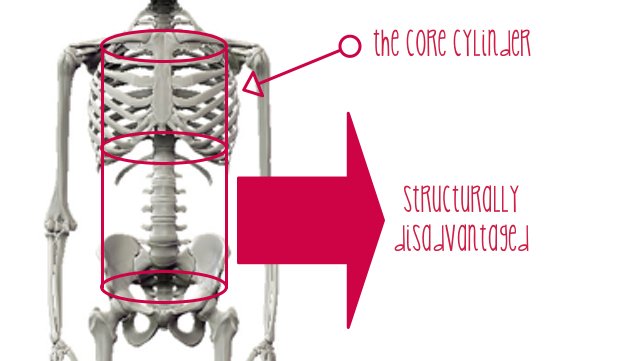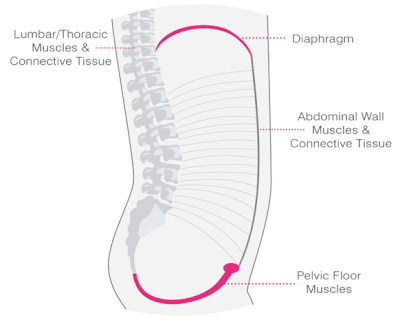UNDERSTANDING YOUR CORE: PART 1
CORE. Thankfully, this is such a familiar word to most of us these days. You'd be hard-pressed to find one gym, trainer or fitness class that doesn't use this word liberally, and maybe even ad nauseam. Our cores have been such a hot topic over the last two decades, which is fantastic, but as with anything trending this also means that there has been plenty of debate and mixed messages about core facts. A few topics of debate: What exactly is the core? What function does it play? What is the best way to engage it? To train it?
These messages are especially confusing when it comes to pregnancy and postpartum rebuilding.
Although there will always be differences in training methods, advice, and opinions on these topics, the research is pretty clear cut when it comes to core anatomy and function these days. And if we know about these two building blocks, then coming up with exercises and training plans that are safe and effective should be pretty simple, but it takes time for research and facts to trickle down through the health industry mosaic. But this is Healthy Mumma and you know I strive to present the real deal, so trust that what follows is the most widely accepted, research-backed, current understanding of the core and its function.
This is CORE 101, mummas. This is about what and where your core is, how it works and why it is so darn important.
This chat is not about core exercises. This is about really knowing your core, because this knowledge is fundamental to owning a body - one that is pain-free and healthy.
MAYBE YOU'VE NEVER THOUGHT OF YOUR CORE MUSCLES AS A FOUNDATION FOR GOOD HEALTH.
IT'S TIME YOU DID.
If you are feeling well versed in your core knowledge (#patonback), by all means, jump over here to PART TWO to make sure you are using it well. Otherwise, keep reading - this is your user guide to your core, part one.
Let’s start with a really simple, but often overlooked, core concept: that your core is exactly that - it is the physical foundation (ahem, core) of you. It is NOT a 6-pack. It is far more. It is the basement of your house (structural!); the necessary innards of the apple (vital!); the centre of our planet (energetic!); the chassis of your car (adaptive!), the trunk of the tree, actually it's more like the roots, but you get the idea. The rest of you would be nothing without it.
My boys have taught me a lot about trucks and diggers and so I can easily relate to Dr. Stuart McGill's analogy of our body behaving like a backhoe. For a backhoe to work well it needs PROXIMAL STABILITY at the cab/engine (your core), which allows the boom to do WORK (your limbs). The boom needs to be in good working order, with all of its parts fully mobile. The ability of the digger to work well is dependent on these two things: 1. STABILITY (proximally) and 2. MOBILITY (more distally).
Your core is structural, functional & dynamic; it is what the rest of your body depends on for support, vitality and movement. In essence, for good health.
Let's put on our Mike Holmes hard hats and take a closer look at what and where your core actually is. Being familiar with its structure will enable you to use it and work it more functionally. Without this understanding, I guarantee that your house will topple, usually in the form of lower back or hip pain - if not today, then some day.
Your core is not your abs.
I know that you know this, because you've heard it already. But really, you need to get this. This is equivalent to saying that your house's foundation is made of one wall, not four.
Your abs (the rectus abdominis) is one muscle of many that make up your core. YOUR CORE IS YOUR ENTIRE TRUNK - shoulder to shoulder, hip to hip. It is your torso. It is the CYLINDER between these points and includes the muscles, connective tissues, cavities and joints.
Your upper core is made up of the rib cage area and all of the muscles in between them and around your shoulder girdles. The lower part of the core is the abdominal area and pelvis, which includes your hip joints. And so there is not one core muscle, but in fact too many to list here unless you want to fall asleep (oh right, you probably do want to fall asleep). Every muscle of your torso is part of your core - with the primary tasks of ABSORBING, STABILIZING, TRANSMITTING and GENERATING major and minor forces, all in a protective and vital way.
Your DIAPHRAGM (which is shockingly large), separates the upper and lower torso and is a big part of the core cylinder. It is the piston of this closed system. The deep breathing yogis know all about this. Your diaphragm provides a huge amount of stability from the inside by helping to moderate your internal pressures as you breathe and move. These internal pressures (thoracic, abdominal, and pelvic) contribute to much of your health, from heart health to digestive health.
The lower part of your trunk is what most people would call the actual core. It is generally the more vulnerable area since it doesn't have the structural integrity of ribs like the upper half of the trunk does. The abdominal area needs to be strong, mobile (to some degree) and adaptive in order to generate, transmit, absorb, and disperse forces. Keeping this lower half healthy is especially important for keeping your spine healthy and injury-free.
The lower part of your core also includes your pelvis. Spanning the floor of your pelvis are your pelvic floor muscles. Your diaphragm, abdominal and pelvic floor muscles all depend on each other for optimal movement and stability. Each needs to be strong and in good working order to maximize efficiency. Contracting and relaxing together, they look like this:
our pelvis is where your centre of mass is (or should be) when you are upright and it is, in my humble opinion, the most structurally important part of our bodies. It is the base of our core cylinder and includes the expanse of pelvic floor muscles - an area all too familiar to pre/post-natal mummas.
So, we've talked about structure quite a bit, but what about FUNCTION. Consider this:
All organs and viscera (except your brain) are
housed in your core.
Think about this for a moment.
THIS IS HUGE.
There is a saying in osteopathy that states that structure governs function. Meaning, the workings of a body organ (heart, lungs, digestive tract, reproductive system, etc.) is dependent on structure - of the position of the organ itself, of the structures that support the organ, of the ligaments, the muscles, the vessels, etc. If your garden hose has a kink (structural problem), water won't flow well (poor function). Such a simple concept, but one that is so overlooked when it comes to our bodies and health.
We are generally pretty terrible at taking care of our structures until they become dysfunctional (re. symptomatic).
Structure governs function.
Remember this.
Try this: slump as much as you can, chin towards chest, head hanging, back rounded, shoulders slumped (hopefully this is not how you were just sitting). Now take a deep breath. How does that feel? Can you feel your chest and ribs fully expanding? Can you feel a deepening and relaxation into your pelvic floor? NOT LIKELY! It likely feels pretty limited.
Now stand up. Stack your rib cage over your pelvis, and take a deep breath. BETTER, RIGHT?
Poor alignment (of your core) significantly limits the functional capacity of your lungs. Poor functional lung capacity means that you are not optimizing the functional capacity of every cell/tissue/organ/muscle in your body.
This concept not only applies to your lung capacity, but to virtually ALL of your vital, bodily functions. THIS IS CRAZY IMPORTANT MUMMAS.
Your heart, your reproductive system, your digestive tract, your muscles - their function all depend on the position they are in, their mobility (are they stuck to another structure?), and the (good and bad) forces imposed on them (are they constantly being compressed with your constantly sucked-in belly?).
This even applies to birthing a baby. Consider the structures and alignment of your core for all body functions.
The take-home message here is that in order to have a pain-free, energetic, healthy, well-functioning body (on all levels), you need a core that is both strong and mobile in order to maintain good alignment of your vital organs, of your joints, and of everything in between.
To sum it all up:
CORE = TRUNK/TORSO (shoulder to shoulder, hip to hip - front, back, sides, top and bottom), with your diaphragm and pelvic floor muscles playing significant roles in this closed core cylinder.
A strong core is vital for the STRUCTURAL INTEGRITY of your entire body. STABILITY is primary here.
Optimal ALIGNMENT (which demands strength) is crucial for optimal FUNCTION of your vital organs and viscera.
OK, so now what?
Knowing that your core is not just your abs and that it is vitally important for your general health will hopefully encourage you to treat it with the respect it deserves if you haven't been doing so already. If you haven't been prioritizing, or really thought about the importance of your core, I hope I've opened your eyes a wee bit to this (ahem) core part of your body.
Now that you have the gist of the core, you need to know HOW TO USE IT. Which is probably the most important thing you need to know ever.






